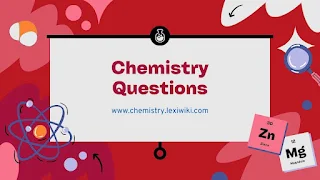Questions on Salt Hydrolysis
SALT HYDROLYSIS – MULTIPLE-CHOICE QUESTIONS
1. What is salt hydrolysis?
A) Dissolution of salts in water
B) Reaction of salts with acids
C) Reaction of salts with water to produce acidic or basic solutions
D) Formation of salts from acids and bases
E) Breaking salts by heating
2. Which of the following salts will result in a neutral solution upon hydrolysis?
A) NH₄Cl
B) NaCl
C) CH₃COONa
D) KCN
E) AlCl₃
3. What is the pH of a solution of NaCl in water?
A) Less than 7
B) Exactly 7
C) Greater than 7
D) Depends on concentration
E) Unmeasurable
4. Which type of salt forms an acidic solution upon hydrolysis?
A) Salt from strong acid and strong base
B) Salt from strong base and weak acid
C) Salt from weak base and strong acid
D) Salt from weak acid and weak base
E) Salt from nonmetal oxides
5. The salt NH₄Cl in water results in what type of solution?
A) Strongly basic
B) Neutral
C) Weakly acidic
D) Weakly basic
E) Strongly acidic
6. What is the conjugate base of a weak acid in salt hydrolysis responsible for?
A) Lowering pH
B) Forming a neutral solution
C) Raising the pH by reacting with water
D) Precipitating from the solution
E) Preventing hydrolysis
7. Which of these salts would create a basic solution in water?
A) NaCl
B) KNO₃
C) CH₃COONa
D) NH₄NO₃
E) AlCl₃
8. Which of the following combinations forms a salt that undergoes complete hydrolysis?
A) Strong acid + strong base
B) Weak acid + strong base
C) Weak base + strong acid
D) Weak acid + weak base
E) Strong base + metal oxide
9. What ion is formed when NH₄⁺ hydrolyzes in water?
A) NH₃
B) H₃O⁺
C) OH⁻
D) NH₂⁻
E) NO₃⁻
10. Which of the following salts comes from a weak acid and weak base?
A) Na₂CO₃
B) NH₄NO₃
C) NH₄CH₃COO
D) KCl
E) NaBr
11. Which pair of ions results in a buffer solution during hydrolysis?
A) Na⁺ and Cl⁻
B) NH₄⁺ and CH₃COO⁻
C) K⁺ and Br⁻
D) Al³⁺ and SO₄²⁻
E) Ca²⁺ and NO₃⁻
12. The pH of a salt solution depends on:
A) Only the anion
B) Only the cation
C) The concentration of salt only
D) Hydrolysis of both cation and anion
E) Temperature only
13. Which salt results in a solution with pH > 7?
A) NH₄Cl
B) KCl
C) Na₂CO₃
D) Al(NO₃)₃
E) FeCl₃
14. What happens to water molecules during salt hydrolysis?
A) They are reduced
B) They act as oxidants
C) They donate or accept protons
D) They condense into a solid
E) They evaporate
15. Which of the following salts would hydrolyze to make the solution acidic due to a metal cation acting as a Lewis acid?
A) NaNO₃
B) MgCl₂
C) CH₃COONa
D) K₂SO₄
E) NH₄NO₃
16. What is the effect of Al³⁺ ion in water?
A) No effect
B) Increases pH
C) Hydrolyzes to form a basic solution
D) Hydrolyzes to form an acidic solution
E) Reacts to form a buffer
17. The CH₃COO⁻ ion in salt hydrolysis can:
A) Donate a proton to water
B) Accept a proton from water
C) Remain inert in solution
D) React with Na⁺ to form CH₃COONa
E) Turn into ethanol
18. Which of the following best defines a hydrolysis constant (Kh)?
A) pH of a salt solution
B) Ka × Kb
C) Equilibrium constant for the hydrolysis reaction
D) Molar mass of a salt
E) pKa + pKb
ANSWER KEY
1. C – Salt hydrolysis refers to the reaction of salt ions with water, resulting in a change in pH.
2. B – NaCl is formed from a strong acid (HCl) and strong base (NaOH) and does not hydrolyze, thus the solution remains neutral.
3. B – The solution of NaCl is neutral with a pH of 7.
4. C – Salts from weak bases and strong acids hydrolyze to give acidic solutions.
5. C – NH₄Cl produces NH₄⁺ which hydrolyzes to release H⁺ ions, making the solution weakly acidic.
6. C – The conjugate base of a weak acid can react with water to produce OH⁻, raising the pH.
7. C – CH₃COONa is the salt of a weak acid (acetic acid) and a strong base (NaOH), so it hydrolyzes to form a basic solution.
8. D – A salt from a weak acid and a weak base undergoes complete hydrolysis as both ions react with water.
9. B – NH₄⁺ + H₂O ⇌ NH₃ + H₃O⁺, forming hydronium (H₃O⁺).
10. C – NH₄CH₃COO is a salt of weak acid and weak base and can undergo complete hydrolysis.
11. B – NH₄⁺ and CH₃COO⁻ can act as a weak acid and base pair, forming a buffer.
12. D – The hydrolysis of both cation and anion influences the final pH.
13. C – Na₂CO₃ comes from a weak acid (carbonic acid) and strong base (NaOH), making the solution basic.
14. C – Water molecules participate in proton transfer reactions during hydrolysis.
15. B – Mg²⁺ acts as a Lewis acid and hydrolyzes to form H₃O⁺, making the solution acidic.
16. D – Al³⁺ hydrolyzes in water, releasing H⁺ ions and making the solution acidic.
17. B – CH₃COO⁻, a weak base, can accept a proton from water to form CH₃COOH.
18. C – The hydrolysis constant (Kh) is the equilibrium constant for the salt's
Dive into the groundbreaking science of neurotransmitters—your brain’s invisible architects—in Chemical Harmony: How Neurotransmitters Shape Our Lives (2025). This meticulously researched book reveals how serotonin, dopamine, GABA, and other brain chemicals silently orchestrate every aspect of your existence, from decision-making and relationships to mental health and emotional resilience.Click here to buy
Share Online!

